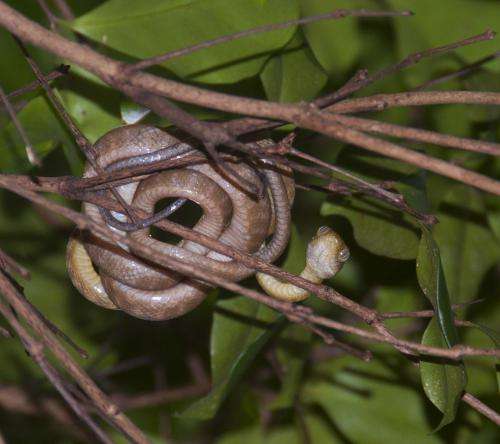The highly invasive brown treesnake wiped out native forest birds on the island of Guam. The effect of the loss of birds is still under investigation. Credit: Isaac Chellman
Ecologists and students from Rice University and the University of Guam will begin an ambitious four-year study this summer to examine how the loss of birds on Guam may be thinning the island's forests as fewer seeds are spread into open gaps.
The invasive brown tree snake has wiped out virtually all birds on the tiny Pacific island. With funding from the National Science Foundation, a Rice-led research team will examine how the loss of fruit-eating birds affects the distribution of 16 tree species in Guam's forests.
"There's a concern that Guam's forests may become filled with open areas and start to look more like Swiss cheese than a closed canopy forest," said Haldre Rogers, the principal investigator (PI) on the new grant. "That's because small birds eat a lot of the small seeds, and quite a few of the pioneer trees—the ones that grow best in open gaps with full sunlight—are small-seeded. Without birds to move their seeds to these sunny spots in the forest, these quick-growing trees may be less likely to germinate or grow to their full size."
Rogers, a Huxley Fellow in Ecology and Evolutionary Biology at Rice, said it's possible that the loss of birds on Guam is already changing the island's tree populations. Some pioneer tree species that are common on nearby islands are very rare in Guam's intact forests. Rogers and grant co-PI Amy Dunham, assistant professor of ecology and evolutionary biology, will go to Guam this summer with undergraduates Jazz Silva and Jeffrey Brown to begin setting up long-term experiments.
The team, which will eventually include a postdoctoral research fellow living on the island, will conduct a series of tests on shade-tolerance of each of the study's 16 tree species in order to predict the impact of losing dispersal to treefall gaps on these species.
"For tree species that are shade tolerant, maybe losing birds doesn't matter that much because they don't need to get to the sunny gaps," Rogers said. "But for the ones that are highly shade intolerant, if their chances of reaching gaps are low because of bird loss, and they can't get a foothold outside the gaps because it is too dark, we would expect to see their populations decline."
Even more concerning than the local decline of some tree species is the possibility that bird loss may change the overall structure of the forest. If seeds from the quick-growing pioneer trees cannot make it to the treefall gaps, then the seedlings that do establish are likely to be slow-growing trees that take a long time to grow tall enough to fill the gap. If gaps stay open longer, there will be more gaps on the landscape, and a hot, open, sunny forest rather than a cool, dark one. Rogers has already found that there are more than twice as many "treefall gaps"—areas devoid of trees—in forests on Guam than on nearby islands, providing some support to this idea.
"Seed-dispersing animals are being lost in a lot of the world's tropical forests right now, but most of the attention so far has been focused on the large-bodied dispersers, the larger primates, mammals and birds that tend to get overhunted first. Hardly anyone is thinking about what happens if you lose small birds, which are much more numerous.
To test how the loss of small birds is affecting Guam's forests, the research team will create new treefall gaps by cutting down individual trees in different areas of Guam's forests and in the forests on two nearby islands that still have birds. Then, the team will examine which seedlings take root in each plot and how long the gaps take to completely fill in on Guam compared with the nearby islands with birds.
Dunham, a tropical ecologist who studies the effects of species loss and species invasions on ecosystems, will spearhead the team's efforts to develop an ecological model that shows how Guam's forests may be relevant for other ecosystems where seed dispersing species are at-risk.
"There are numerous theories about community assembly in which seed dispersal plays an important role, and animals involved in seed-dispersal are in decline in a lot of tropical forests around the world right now," Dunham said. "It's very important to understand the implications of those declines. The situation on Guam—which is tragic—provides us with a unique opportunity to see what happens when all seed-dispersal services provided by animals are lost from an entire ecosystem."
More information: To learn more about the research, see Silva and Brown's poster presentation April 12 at the Rice Undergraduate Research Symposium from 10 a.m. to 1 p.m. in Tudor Fieldhouse. ofur.rice.edu/content.aspx?id=4294967413
Provided by Rice University























